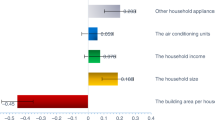Abstract
Exploring the underlying driving factors of building energy consumption(BEC) can provide advices for future policy making. The purpose of this paper is to adopt Logarithmic Mean Divisia Index (LMDI) method to analyze a decomposition of BEC in Chongqing during the study time 2000–2014. The research results have shown that the behavior effect is the most significant factor of increasing BEC in Chongqing. It has also found that the floor area effect, urbanization rate effect and population effect also have a positive impact on increasing BEC. However, the energy efficiency effect has had a dampening impact on BEC. Finally, we suggest that “a low-carbon lifestyle” is an effective way to control the future increasing of BEC both in the urban and rural region in Chongqing.
Similar content being viewed by others
References
Ang BW, Liu FL, Chung H-S (2004) A generalized Fisher index approach to energy decomposition analysis. Energy Econo 26(5):757–763
Center, T.U.B.E.C.R (2016) Annual report on China building energy efficiency
Chongqing Statistical Yearbook (2001–2015) National bureau of statistics of China
Chu P-Y, Lin Y-L, Guo C-S (2016) The effect of ecological elasticity in Taiwan’s carbon reduction policies: the STIRPAT model. J Manage Sustain 6(1):121
Ehrlich PR, H.J.P (1971) Impact of population growth
Fan Y et al (2006) Analyzing impact factors of CO2 emissions using the STIRPAT model. Environ Impact Assess Rev 26(4):377–395
Fan F, Lei Y (2016) Decomposition analysis of energy-related carbon emissions from the transportation sector in Beijing. Transp Res Part D: Transport Environ 42:135–145
Hou J et al (2016) Comparative study of commercial building energy-efficiency retrofit policies in four pilot cities in China. Energy Policy 88:204–215
IPCC (2014) Climate change 2013: summary for policymakers
Ji X, Chen B (2015) Assessing the energy-saving effect of urbanization in China based on stochastic impacts by regression on population, affluence and technology (STIRPAT) model. J Cleaner Prod
Li B, Liu XJ, Li ZH (2015) Using the STIRPAT model to explore the factors driving regional CO2 emissions: a case of Tianjin, China. Nat Hazards 76(3):1667–1685
Lin B, Liu H (2015) China’s building energy efficiency and urbanization. Energy Build 86:356–365
Liu Y. et al. (2016) Driving factors of carbon dioxide emissions in China: an empirical study using 2006–2010 provincial data. Front Earth Sci
SBCI U (2009) Buildings and climate change: a summary for decision-makers. Available from: http://www.unep.org/SBCI/pdfs/SBCI-BCCSummary.pdf
Tan XC et al (2016) China’s regional CO2 emissions reduction potential: a study of Chongqing city. Appl Energy 162:1345–1354
Wang Q et al (2016) Exploring the relationship between urbanization, energy consumption, and CO2 emissions in different provinces of China. Renew Sustain Energy Rev 54:1563–1579
Wang S. et al. (2016) The relationship between economic growth, energy consumption, and CO2 emissions: empirical evidence from China. Sci Total Environ 542(Pt A):360–371
Xu B, Luo L, Lin B (2016) A dynamic analysis of air pollution emissions in China: evidence from nonparametric additive regression models. Ecol Ind 63:346–358
Yang X, Wei QP, Jiang Y (2007) Study on statistical method for building energy consumption. Constr Conserv Energy
Yang L, Yan H, Lam JC (2014) Thermal comfort and building energy consumption implications—a review. Appl Energy 115:164–173
York R, Rosa EA, Dietz T (2003) STIRPAT, IPAT and ImPACT: analytic tools for unpacking the driving forces of environmental impacts. Ecol Econ 46(3):351–365
Zhou L, Chen WY (2015) Status and decomposition analysis on building energy consumption of China in the last decade. J Renew Sustain Energy 7(6)
Acknowledgements
This research was supported by grants from the Social Science and Humanity on Young Fund of the Ministry of Education P.R. China (No. 15YJC630003).
Author information
Authors and Affiliations
Corresponding author
Editor information
Editors and Affiliations
Rights and permissions
Copyright information
© 2018 Springer Nature Singapore Pte Ltd.
About this paper
Cite this paper
Wang, X., Ren, H., Cai, W., Liu, Y. (2018). Index Decomposition Analysis of Building Energy Consumption in Chongqing: 2000–2014. In: Chau, K., Chan, I., Lu, W., Webster, C. (eds) Proceedings of the 21st International Symposium on Advancement of Construction Management and Real Estate. Springer, Singapore. https://doi.org/10.1007/978-981-10-6190-5_82
Download citation
DOI: https://doi.org/10.1007/978-981-10-6190-5_82
Published:
Publisher Name: Springer, Singapore
Print ISBN: 978-981-10-6189-9
Online ISBN: 978-981-10-6190-5
eBook Packages: Business and ManagementBusiness and Management (R0)




